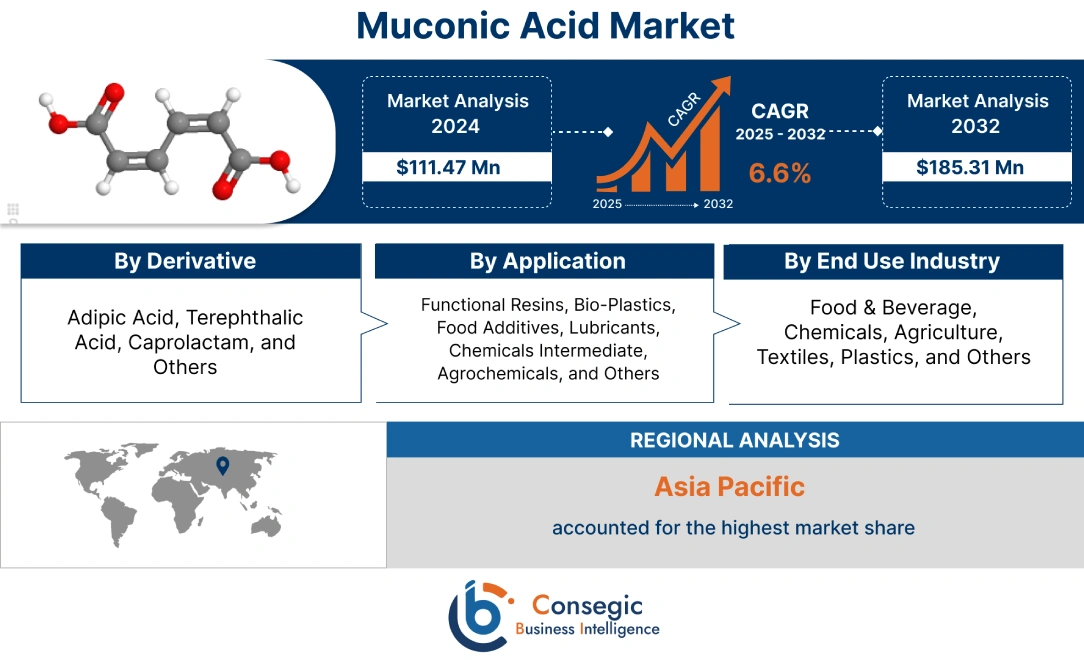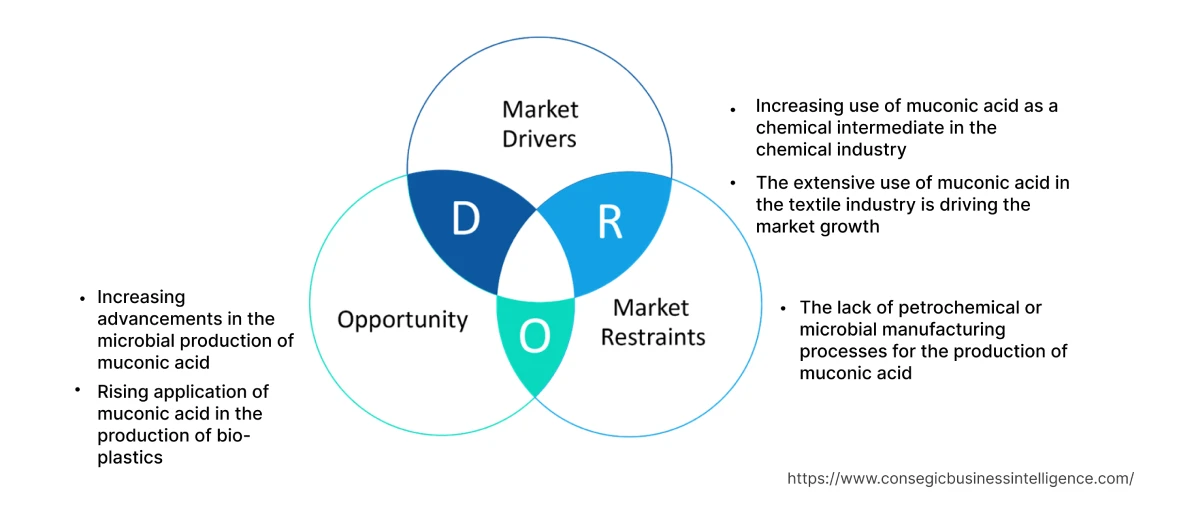Muconic Acid Market Introduction :
Muconic Acid Market size is estimated to reach over USD 185.31 Million by 2032 from a value of USD 111.47 Million in 2024 and is projected to grow by USD 116.8 Million in 2025, growing at a CAGR of 6.60% from 2025 to 2032.
Muconic Acid Market Definition & Overview:
Muconic acid, also known as cis-cis hexadienedioic acid. This acid is a dicarboxylic acid that is produced through the degradation of chlorobenzene by various bacteria including bacillus. The acid is a naturally occurring organic compound that finds a wide range of applications in various end use industries such as textile, pharmaceutical, food & beverage, and chemicals. In the textile sector, based on the analysis, this acid is used in the production of nylon which offers rigidity, mechanical strength, and good stability. Whereas in the plastic sector, the chemical is deployed as a functional copolymer due to the presence of two double bonds in the structure. The utilization of this acid in the chemical sector is further driving the market.
Muconic Acid Market Insights :
Key Drivers :
Increasing use of muconic acid as a chemical intermediate in the chemical sector
This acid is used as a chemical intermediate for the production of various important chemicals such as adipic acid and diethyl terephthalate that are further used by the various end use industries as base chemicals. For instance, diethyl terephthalate produced from this acid is deployed as a plasticizer in the production of polyester owing to the ability to modify and improve materials. Hence, the increasing demand for the muconic acid industry from the expanding chemical sector is contributing to the development of the market.
The extensive use of muconic acid in the textile sector is driving the market
It is widely used as a potential chemical for the manufacturing of nylon by polycondensation reaction. In addition, the compound is also used in the synthesis of polyester polyols. The wide adoption of nylons and polyester polyols in the textile sector owing to the properties such as water resistance and mechanical strength in products including clothing and carpets is contributing to the muconic acid market growth. Additionally, the rising investment in the textile sector to develop modified engineered products including high-temperature nylon (HTN) and nylon 6.6 is also accelerating the demand for this acid. For instance, DOMO Chemicals, a producer of high-quality nylon materials, invested USD 13.05 million in a new plant of nylon in China. Therefore, the above-mentioned factors are propelling the market.
Key Restraints :
The lack of petrochemical or microbial manufacturing processes for the production of muconic acid
Muconic acid is a potential chemical that is produced in an engrained strain of pseudomonas putidahas which finds various applications including pharmaceuticals, textiles, and agrochemicals, among others. However, the lack of any specific microbial or petrochemical processes to produce the chemical is resulting in a less supply of this acid as a commodity chemical. As a result, restraining the market development due to the less availability of the chemical. Thus, the aforementioned factor are restraining the market.
Future Opportunities :
Increasing advancements in the microbial production of muconic acid
The increasing advancements in microbiology such as well-established molecular tools and fermentation techniques have led to the building of metabolism that did not exist before. As a result, as per the analysis the synthesis of this acid through various microbial processes is anticipated to offer lucrative muconic acid market opportunities to the key players operating in the market. For instance, the increasing usage of industrial biomass and agricultural waste is raising the interest of various chemical manufacturers. Out of such waste materials, lignocellulose which is a plant dry mass is expected to serve as a potential raw material for the production of this acids. Thus, the advancements in microbial production of this acid is creating lucrative opportunities and trends in the upcoming years.
Rising application of muconic acid in the production of bio-plastics
The growing need for sustainable products that cause less harm to the environment is increasing the requirement for this acids. It is widely used in the production of bioplastics. In addition, the increasing government initiatives and policies regarding synthetic plastic use is expected to offer lucrative opportunities in the muconic acid market. For instance, the U.S introduced the Plastics Pact in August 2020 that aims to reuse plastics which would replace new plastics. Therefore, the above-mentioned factors are anticipated to boost the market expansion over the forecast period.
Muconic Acid Market Report Insights :
| Report Attributes | Report Details |
| Study Timeline | 2019-2032 |
| Market Size in 2032 | USD 185.31 Million |
| CAGR (2025-2032) | 6.6% |
| By Derivative | Adipic Acid, Terephthalic Acid, Caprolactam, and Others |
| By Application | Functional Resins, Bio-Plastics, Food Additives, Lubricants, Chemicals Intermediate, Agrochemicals, and Others |
| By End Use Industry | Food & Beverage, Chemicals, Agriculture, Textiles, Plastics, and Others |
| By Region | North America, Europe, Asia-Pacific, Latin America, Middle East & Africa |
| Key Players | Alfa Aesar (subsidiary of Thermo Fisher Scientific), Merck KGaA, Santa Cruz Biotechnology, Inc., Tokyo Chemical Industry Co., Ltd., Toronto Research Chemicals, Inc., VWR International, LLC, LGC Limited, Sisco Research Laboratories Pvt Ltd, Parchem fine & specialty chemicals |
Muconic Acid Market Segmental Analysis :
Based on the Derivative :
The derivative segment is categorized into adipic acid, terephthalic acid, caprolactam, and others. In 2024, the adipic acid segment held the highest muconic acid market share of 33.50% in the market. The development of the segment is attributed to the increasing adoption of adipic acid in the production of nylon that is further processed for various applications including carpeting, clothing, and automobile tire cord. In addition, the rising deployment of the compound in the expanding pharmaceutical sector owing to their ability to control acidic and basic release of other drugs is also proliferating the demand for adipic acid. For instance, according to the India Brand Equity Foundation, the pharma sector in India is projected to reach at USD 130 billion by 2030. Hence, the growing textile and pharmaceutical industries are contributing to the market expansion and trends.
Moreover, the terephthalic acid segment is expected to register the fastest CAGR in the muconic acid market. The extensive application of terephthalic acid as a raw material to produce various drugs is anticipated to proliferate muconic acid market trend. Additionally, as per the analysis, the wide scope of application of hot melt adhesives in various end use industries including rubber, plastics, and glass, among others is also projected to surge the demand for the compound. This is due to the use of terephthalic acid in the production of hot melt adhesive. Thus, the aforementioned factors are propelling the market.
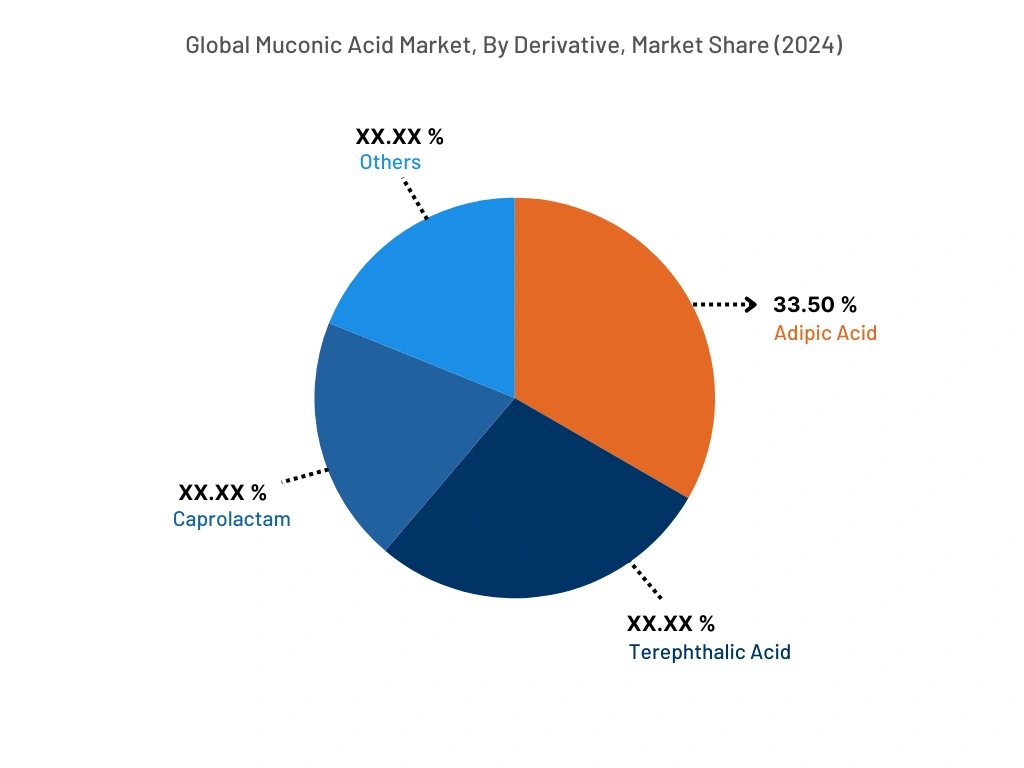
Based on the Application :
Based on application segment, the market is dived into functional resins, bio-plastics, food additives, lubricants, chemicals intermediate, agrochemicals, and others. In 2024, the chemical intermediate segment accounted for the highest market revenue of the muconic acid market. Based on the analysis, this acid is widely adopted as the raw material in the production of various compounds that are further applied as base chemicals in other end use industries. For instance, this acid is widely deployed in the production of caprolactam which is used in the manufacturing of synthetic fibers in the textile sector. Hence the increasing application of this acid in the production of other potential chemicals is propelling the expansion of muconic acid market. Thus, the aforementioned factors are propelling the expansion of the sement.
However, the bio plastics segment is expected to witness the fastest CAGR over the forecast period. The rising adoption of bio-plastics due to shifting trends towards bio-based products is anticipated to accelerate the muconic acid market demand. For instance, as per the report published by PlasticsEurope AISBL, in 2021 bio-based plastic accounted for 8.3% of the global world plastic production. In addition, the shifting consumer preference towards eco-friendly products is urging manufacturers to move towards renewable and bio-based feedstocks, as a result anticipated to proliferate the market expansion and trend.
Based on the End Use Industry :
The end use industry segment is categorized into food & beverage, chemicals, agriculture, textiles, plastics, and others. The chemicals segment held the highest market share in the overall muconic acid market. This is due to the rising application of this acid as a chemical intermediate for the production of various industrial chemicals such as adipic acid, terephthalic acid, and caprolactam. In addition, as per the analysis, the expanding chemical sector, particularly in the growing economies including India and China is also propelling the trend of the market. For instance, as per the report published by Invest India, the petrochemical & chemical sector is projected to reach USD 300 billion by 2025. Hence, the above-mentioned factors are contributing to the market trend of the segment.
Moreover, the textile segment is anticipated to register the fastest CAGR over the forecast period. The wide adoption of this acid in the production of nylon is expected to surge the growth of the market. As per the analysis, this is due to the extensive use of nylon by various end use industries such as automotive, and electronics owing to its high elasticity and good mechanical strength. Therefore, the rising for muconic -based-nylon is expected to proliferate the market growth over the forecast period.
Based on the Region :
The regional segment includes North America, Europe, Asia Pacific, the Middle East and Africa, and Latin America.
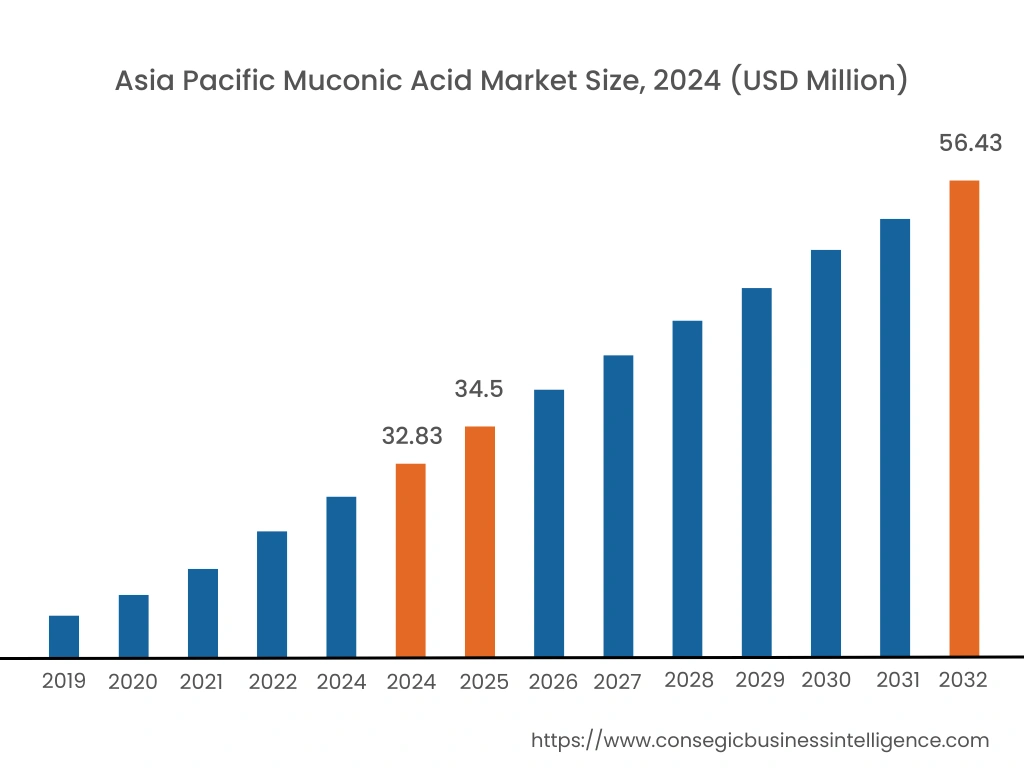
Asia Pacific accounted for the highest market share at 42.15% and was valued at USD 32.83 Million in 2024. Moreover, it is projected to grow by USD 34.5 Million in 2025 and reach over USD 56.43 Million by 2032. In Asia Pacific, China accounted for the highest market share of 42.85% during the base year of 2024. Based on the analysis, the rising consumption of textiles due to the increasing population along with shifting clothing trends is driving the market growth in the region. Additionally, the growing chemical sector in the region, due to the presence of major chemical-producing countries including India and China is also propelling the growth of the market.
However, North America is expected to register the fastest CAGR of 7.2% during the forecast period. As per the muconic acid market analysis, the rising concern among consumers and governments of various countries in the region regarding the use of fossil fuel-based plastics products is fueling market growth. For instance, in April 2023, U.S., President Joe Biden announced the aim to replace 90% of fossil fuel-based plastic with bio-plastics over 20 years. Hence, the rising demand for sustainable and eco-friendly products is accelerating the growth of muconic acid market.
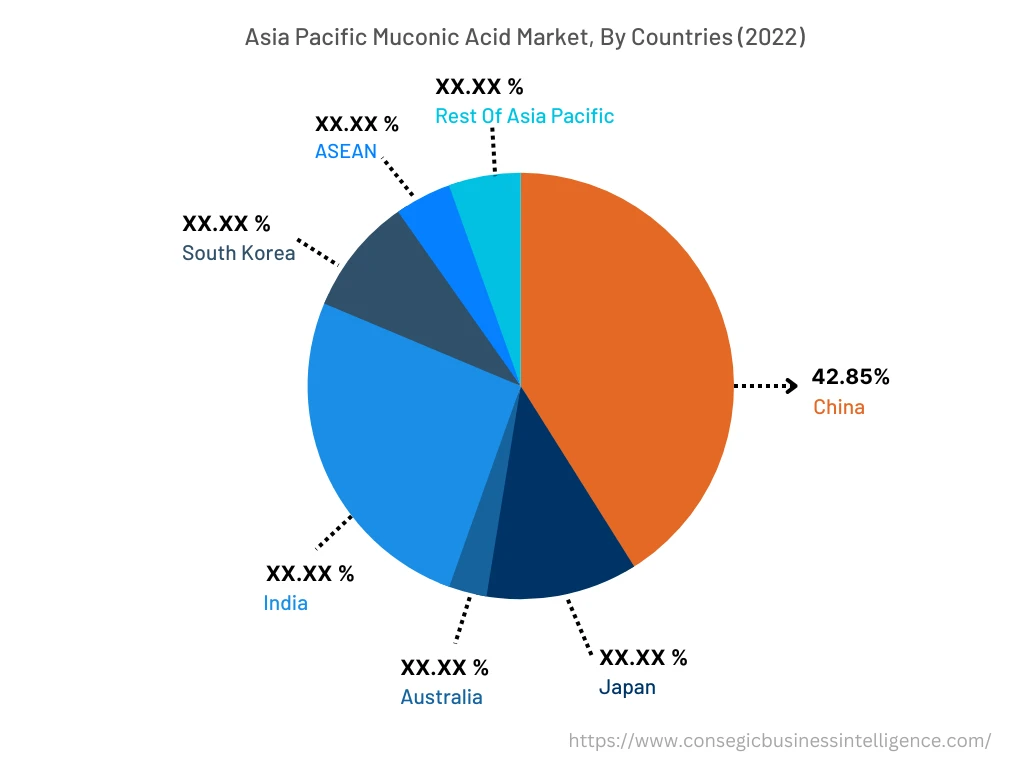
Top Key Players & Market Share Insights:
The muconic acid market is highly competitive, with several large players and numerous small and medium-sized enterprises. These companies have strong research and development capabilities and a strong presence in the market through their extensive product portfolios and distribution networks. The market is characterized by intense competition, with companies focusing on expanding their product offerings and increasing their market share through mergers, acquisitions, and partnerships. The key players in the market include-
- Alfa Aesar (a subsidiary of Thermo Fisher Scientific
- Merck KGaA
- Sisco Research Laboratories Pvt Ltd
- Parchem fine & specialty chemicals
- Santa Cruz Biotechnology, Inc.
- Tokyo Chemical Industry Co., Ltd.
- Toronto Research Chemicals, Inc.
- VWR International, LLC
- LGC Limited
Key Questions Answered in the Report
What was the market size of the muconic acid industry in 2024? +
In 2024, the market size of muconic acid was USD 111.47 million.
What will be the potential market valuation for the Muconic Acid industry by 2032? +
In 2032, the market size of muconic acid will be expected to reach USD 185.31 million.
What are the key factor driving the growth of the muconic acid market? +
Increasing demand for muconic acid in the chemical industry as a chemical intermediate is the key factor driving the growth of the muconic acid market.
What is the dominating segment in the muconic acid market by derivative? +
In 2024, the adipic acid accounted for the highest market share of 33.50% in the overall muconic acid market.
Based on current market trends and future predictions, which geographical region will have the fastest impact on the Muconic Acid market's growth in the coming years? +
North America is expected to be the fastest-growing region in the market during the forecast period.
